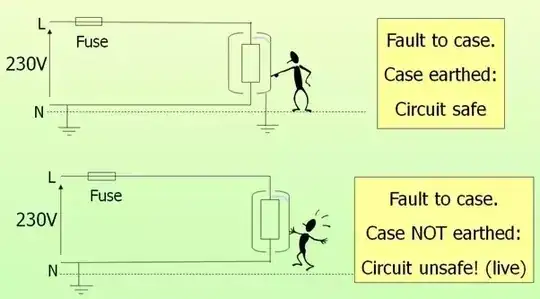Usually the chassis of any household equipment is connected to earth ground for safety.
The illustration you provided is slightly misleading. Typically, when a live-to-chassis fault occurs and the chassis is grounded, the resulting short circuit current will trip a circuit breaker or blow a fuse in an electrical panel. If the current is insufficient to blow a fuse or trip a circuit breaker, then there is sufficient resistance in the circuit that goes through the chassis to keep the current below the trip level. If there is such sufficient resistance, then the chassis is potentially unsafe to touch.
When a the circuit breaker trips, or the fuse blows, the fault must be cleared (repaired) in order to for the circuit breaker / fuse not to trip again when it is reset.
My question is for an aircraft power supply (115V/400Hz AC), why is the neutral not connected to chassis GND? (In fact, the standard specifies strict isolation between the power lines and chassis GND.)
No design for safety is perfect. But the risks in an aircraft are significantly different from the risks in a house or in a car.
First, consider the risks associated with isolating the chassis from the electrical system. Such a system is safe if there is only one isolation failure. The danger of shock requires a circuit. For someone to receive a shock through the chassis, there must be a fault between the electrical system and the chassis, and a "fault" between some piece of equipment and a passenger.
Aircraft have periodic and continuous monitoring of important safety parameters. I'm not an expert in the area, but I assume there are either periodic or continuous tests of the resistance between the chassis and the electrical system. Thus a single electrical-system-to-chassis fault will be discovered and corrected, hopefully before a second, shock-producing, fault occurs. The quality control standards for electrical work in aircraft are higher than for general (i.e. residential) electrical work. Together these make isolated chassis systems in aircraft quite safe from shock.
In contrast, in a residence, an electrical safety issue might not get fixed unless it causes a noticeable (and annoying) problem with service. When residential electrical systems rely on isolation, a single fault might go undiscovered, and/or uncorrected until someone receives a shock. Thus, isolated power is less safe in a residential setting than in a aircraft.
But avoiding dangerous electrical shocks and fires is not the only safety concern in aircraft. As mentioned above, part of the safety mechanism associated with the grounding of chassis is the expected overcurrent associated with a fault causing a circuit breaker to trip (or fuse to blow). In an aircraft setting, one must consider the safety issue of a possible loss of power to an electrical circuit during flight due to a single fault.
In some cases the consequences will be rather benign, like passenger's being unable to use their laptops. In other cases, loss of a circuit might be much more significant to flight safety.
No safety design is perfect, but given the factors above, using an isolated electrical system, rather than bonding the chassis to one of the electrical system conductors, seems a sound safety design choice for aircraft.

